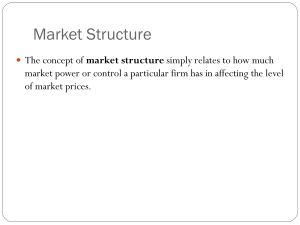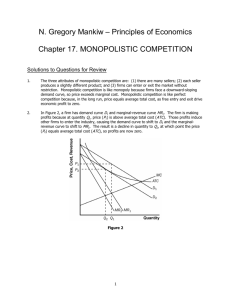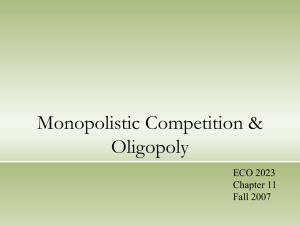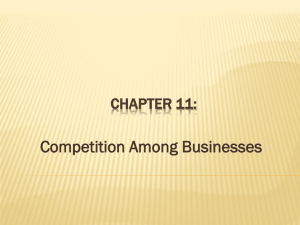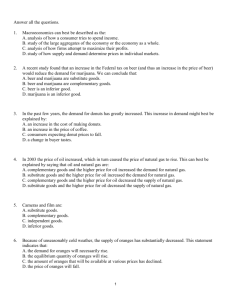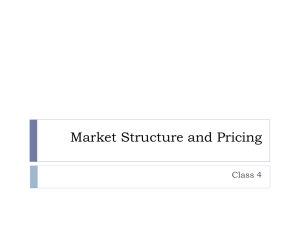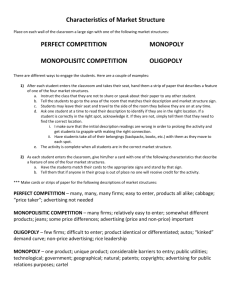apecon ch11 answers homework B
advertisement
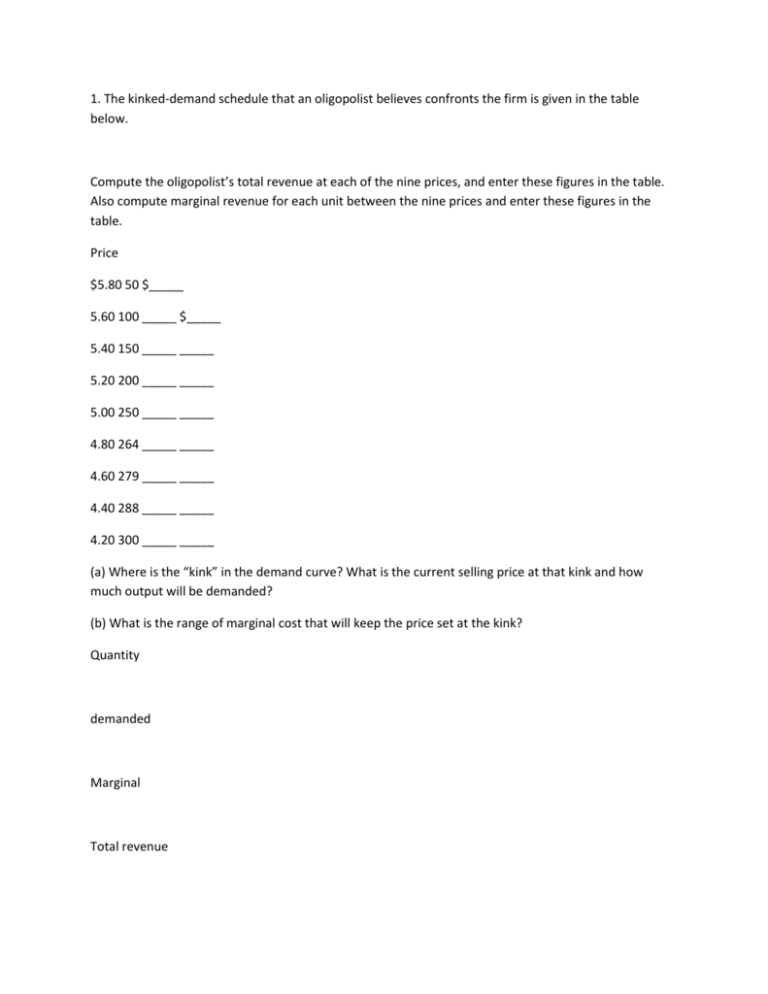
1. The kinked-demand schedule that an oligopolist believes confronts the firm is given in the table below. Compute the oligopolist’s total revenue at each of the nine prices, and enter these figures in the table. Also compute marginal revenue for each unit between the nine prices and enter these figures in the table. Price $5.80 50 $_____ 5.60 100 _____ $_____ 5.40 150 _____ _____ 5.20 200 _____ _____ 5.00 250 _____ _____ 4.80 264 _____ _____ 4.60 279 _____ _____ 4.40 288 _____ _____ 4.20 300 _____ _____ (a) Where is the “kink” in the demand curve? What is the current selling price at that kink and how much output will be demanded? (b) What is the range of marginal cost that will keep the price set at the kink? Quantity demanded Marginal Total revenue per unitrevenue 224 Monopolistic Competition and Oligopoly Quantity demanded Marginal Total revenue per unit revenue Price $5.80 50 $ 290 5.60 100 560 $ 5.40 5.40 150 810 5.00 5.20 200 1040 4.60 5.00 250 1250 4.20 4.80 264 1267 1.21 4.60 279 1283 1.07 4.40 288 1267 –1.77 4.20 300 1260 –0.58 (a) The “kink” occurs at a price of $5.00 and output of 250 units. (b) The marginal cost can change from $4.20 to $1.22 and the price will remain at $5.00 and output at 250 units. [text: E pp. 234-236; MI pp. 234-236] 2. What is the price leadership model of oligopoly pricing and what are its tactics? Price leadership is a covert and generally legal form of collusion in which one firm traditionally initiates price changes and the other firms in the industry follow the lead. Three price leadership tactics have been observed. First, price adjustments tend to be made infrequently and only as cost and demand conditions change to a significant degree. Second, the price leader will announce price changes through speeches, announcements, or other such activities to solicit a consensus. Third, the going price may not maximize profit in the short run for the firms in the industry, especially if the firms want to prevent entry by other firms. [text: E p. 239; MI p. 239] 3. Compare pure competition, pure monopoly, monopolistic competition, and oligopoly on each of the following points: (a) Ability to manipulate price. (b) Flexibility of prices. (c) Expenditures on advertising and sales promotion. (d) Efficiency in allocation of resources. (a) Firms have least ability to manipulate price in pure competition, some ability in oligopoly depending on conditions, a slight ability under monopolistic competition, and total ability in a monopoly. [text: pp. 177, 202, 223, 230; MI: pp. 177, 202, 223, 230] (b) Prices would be most flexible under monopolistic competition and pure competition. Under pure competition, prices would change only if market demand or supply conditions changed, but the firm would not have control over this flexibility. Prices under oligopoly would not be flexible; rather output adjustments would tend to be made to changing demand conditions. Monopoly prices could be flexible in response to changing demand or cost conditions. [text: pp. 177, 202, 223, 230; MI: pp. 177, 202, 223, 230] (c) Purely competitive firms would spend virtually nothing on advertising. Monopolistic competitors and oligopolies with differentiated products would spend the most. Monopolies would probably spend a slight amount on informational or goodwill advertising. [text: E pp. 177, 202, 224, 240; MI pp. 177, 202, 224, 240] (d) Productive and allocative efficiency are achieved only under conditions of pure competition, with the qualification that in some industries, economies of scale dictate some other market model to achieve efficiency. Among the other three models, it would depend on the circumstances. In a regulated, natural monopoly, efficiency may nearly be achieved. In monopolistic competition without excessive advertising, and in oligopolies realizing economies of scale, efficiency may be attained. [text: E pp. 177-178, 210-211, 227-228, 241; MI pp. 177-178, 210-211, 227-228, 241] 4. (Last Word) Describe the major demand and supply factors that have turned the beer industry into an oligopoly over the years. In 1947 there were 400 independent brewers in the U.S., but today the two major brewers account for almost 70% of the market. One reason for this change is that demand changed. Preferences shifted from stronger-flavored beers to lighter, dryer products. Consumption also shifted from taverns to homes, which resulted in a different kind of packaging. On the supply-side, technology changed and produced significant economies of scale that now constitute a barrier to entry. Although mergers have occurred, they are not the fundamental cause of increased concentration. Advertising and product differentiation have been important in the growth of some firms and as a way to create market dominance. [text: E pp. 242-243; MI pp. 242-243] 5. You are a consultant from DHS, Inc. to Lowe’s Home Improvement Corp.. They are currently building a new store on Route 1 in Norwalk. A. Based on the First Mover and Preemption of Entry strategy advise them whether this is a winning or losing strategy and explain why? It is true that a first-mover firm may be able to preempt the market entry of other firms. A first-mover advantage takes place in sequential games where one player moves first and commits to a strategy that is then taken into consideration by the other player before making a decision. The firm that moves first can take advantage of this option and choose a strategy that is only profitable for that firm, thus forcing the other firm out of the market. Firms such as Wal-Mart and Krispy Crème Donuts are well known for using this strategy and forcing competitors out of business. [text: E pp. 247-248; MI pp. 247-248] B. It would be surprising if Lowe’s wasn’t aware of these issues, so why do you think they chose to enter the Norwalk/Darien/Westport/New Canaan market? ? Reciprocity? Sufficient demand that both may make a profit?



